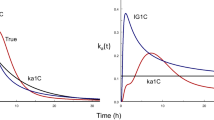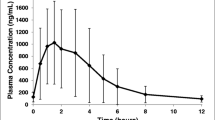Summary
Seven normal human volunteers each received a constant-rate infusion of chlorthalidone for 2 h, and the same (commonly 50 mg) single oral dose on separate occasions. The concentration of unchanged chlorthalidone was analyzed over a 100 to 220 h period in plasma, red blood cells, urine and faeces after both dosage forms. A three compartment model was required to describe the intravenous plasma concentrations in five of the subjects. A two compartment model sufficed to account for the decay of the oral plasma concentrations in all seven subjects. The mean plasma t1/2 after i.v. dosing was 36.5 h (±10.5 SD), and the mean plasma t1/2 after oral doses was 44.1 h (±9.6 SD). The mean red blood cell concentration t1/2 after i.v. doses was 46.4 h (±9.9 SD), and the mean red blood cell t1/2 after the oral doses was 52.7 h (±9.0 SD). The shorter i.v. half-live was not equally manifest in all subjects, being mainly apparent in three of them. In all cases the urinary excretion rate plots were parallel to the plasma concentration curves. As the faster decay after i.v. administration was not accompanied by increased renal clearance, the difference must have been due to non-renal mechanism. The mean total of 65.4 (±8.6 SD) % of the intravenous dose was excreted in urine over infinite time, whereas the mean total excretion after the oral dose was 43.8 (±8.5 SD) %. Faecal excretion ranged from 1.3–8.5% of dose in the i.v. study to 17.5–31.2% of dose in the oral study. The sum of the amounts present in urine plus faeces pointed strongly to an important metabolic route of elimination of chlorthalidone. Bioavailability estimates (F) from three sets of data were — a mean F of 0.61 from plasma concentrations, 0.67 from urinary excretion measurements and 0.72 from the erythrocyte concentrations. Simulations with a non-linear model indicated lesser validity of the estimate from erythrocyte concentrations. It was concluded that the average of plasma and urine data, F=0.64, yielded the best estimate of the oral availability of chlorthalidone 50 mg in man.
Similar content being viewed by others
References
Stenger, E.G., Wirz, H., Pulver, R.: Hygroton (G 33182), ein neues Salidiureticum mit protrahierter Wirkung. Schweiz. Med. Wochenschr.89, 1126–1130 (1959)
Beermann, B., Hellström, K., Lindström, B., Rosén, A.: Binding-site interaction of chlorthalidone and acetazolamide, two drugs transported by red blood cells. Clin. Pharmacol. Ther.17, 424–432 (1975)
Fleuren, H.L.J., van Rossum, J.M.: Pharmacokinetics of chlorthalidone in man. Pharm. Weekbl.110, 1262–1264 (1975)
Collste, P., Garle, M., Rawlins, M.D., Sjöqvist, F.: Interindividual differences in chlorthalidone concentration in plasma and red cells of man after single and multiple doses. Europ. J. clin. Pharmacol.9, 319–325 (1976)
Fleuren, H.L.J., van Rossum, J.M.: Nonlinear relationship between plasma and red blood cell pharmacokinetics of chlorthalidone in man. J. Pharmacokin. Biopharm.5, 359–375 (1977)
Riess, W., Dubach, U.C., Burckhardt, D., Theobald, W., Vuillard, P., Zimmerli, M.: Pharmacokinetic studies with chlorthalidone (Hygroton®) in man. Europ. J. clin. Pharmacol.12, 375–382 (1977)
Fleuren, H.L.J., van Rossum, J.M.: Determination of chlorthalidone in plasma, urine and red blood cells by gaschromatography with nitrogen detection. J. Chromat.152, 41–54 (1978)
Boxenbaum, H.G., Riegelman, S., Elashoff, R.M.: Statistical estimations in pharmacokinetics. J. Pharmacokin. Biopharm.2, 123–148 (1974)
Wagner, J.G.: Linear pharmacokinetic equations allowing direct calculation of many needed pharmacokinetic parameters from the coefficients and exponents of polyexponential equations which have been fitted to the data. J. Pharmacokin. Biopharm.4, 443–467 (1976)
van Rossum, J.M.: Significance of pharmacokinetics for drug design and the planning of dosage regimens. In: Drug Design, Vol. I (E.J. Ariëns (ed.), pp. 469–521, New York, London: Academic Press 1971
Gibaldi, M., Perrier, D.: Pharmacokinetics, pp. 37–38. New York: Marcel Dekker 1975
Gibaldi, M., Perrier, D.: Pharmacokinetics, pp. 145–149. New York: Marcel Dekker 1975
Levy, G.: Effect of bed rest on distribution and elimination of drugs. J. Pharm. Sci.56, 928–929 (1967)
Werner, S.C., Ingbar, S.H.: The Thyroid, 3rd ed. New York: Harper and Row 1971
Beisenherz, G., Koss, F.W., Klatt, L., Binder, B.: Distribution of radioactivity in the tissues and excretory products of rats and rabbits following administration of C14-Hygroton®. Arch. int. Pharmacodyn.161, 76–93 (1966)
Dieterle, W., Wagner, J., Faigle, J.W.: Binding of chlorthalidone (Hygroton®) to blood components in man. Europ. J. clin. Pharmacol.10, 37–42 (1976)
Maren, T.H.: The binding of inhibitors to carbonic anhydrase in vivo: drugs as markers for enzyme. Biochem. Pharmacol.9, 39–48 (1962)
Wallace, S.M., Shah, V.P., Riegelman, S.: GLC analysis of acetazolamide in blood, plasma and saliva following oral administration to normal subjects. J. Pharm. Sci.66, 527–530 (1977)
Pulver, R., Wirz, H., Stenger, E.G.: Über das Verhalten des Diureticums Hygroton (G33182) im Stoffwechsel. Schweiz. Med. Wochenschr.89, 1130–1133 (1959)
Author information
Authors and Affiliations
Rights and permissions
About this article
Cite this article
Fleuren, H.L.J., Thien, T.A., Verwey-van Wissen, C.P.W. et al. Absolute bioavailability of chlorthalidone in man: A cross-over study after intravenous and oral administration. Eur J Clin Pharmacol 15, 35–50 (1979). https://doi.org/10.1007/BF00563556
Received:
Revised:
Accepted:
Issue Date:
DOI: https://doi.org/10.1007/BF00563556




